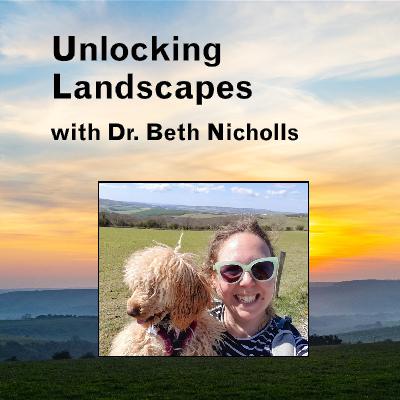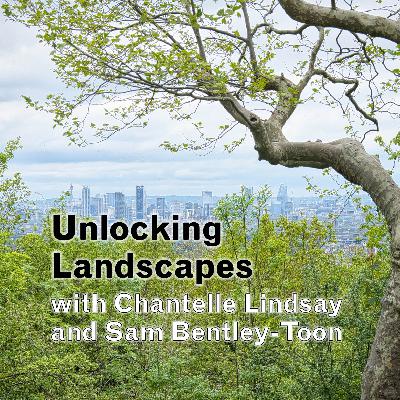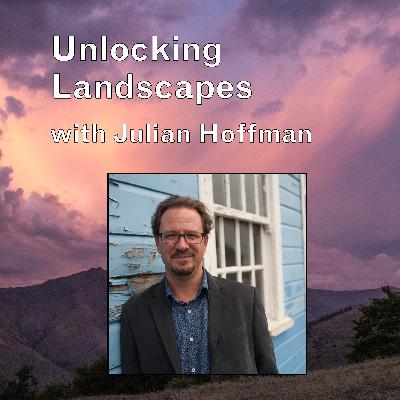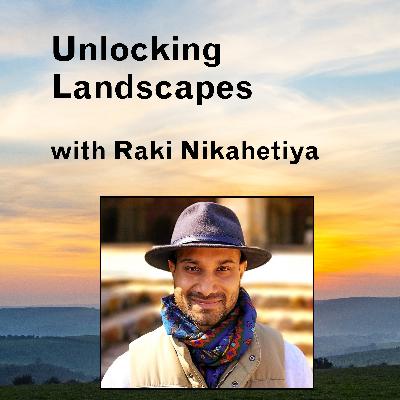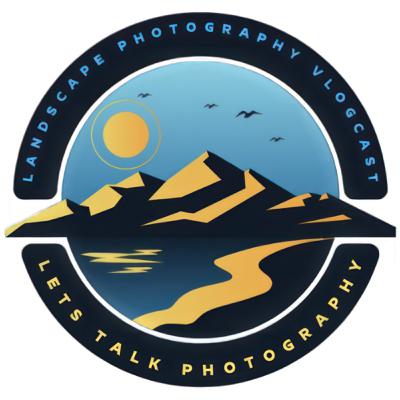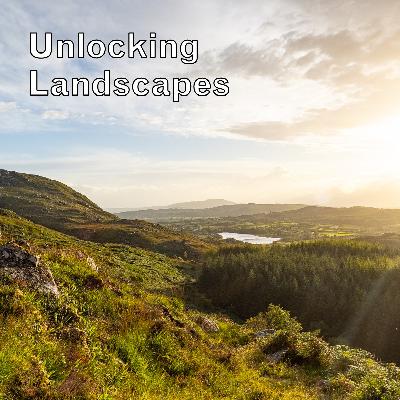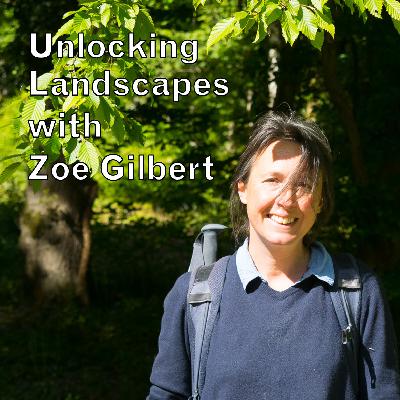Discover Unlocking Landscapes
Unlocking Landscapes

Unlocking Landscapes
Author: Daniel Greenwood
Subscribed: 4Played: 61Subscribe
Share
© Copyright 2021 All rights reserved.
Description
Hosted by writer and photographer Daniel Greenwood, Unlocking Landscapes is a non-profit podcast that launched in 2021. UL focuses on our complex connections with nature and history through the landscape. Expect guided walks, species identification, open conversations, birdsong and more.
17 Episodes
Reverse
On Good Friday 2025 I went for an evening walk in the Weald of West Sussex, an area of ancient woodland 30 miles to the south of London.
Is ivy (Hedera helix) bad for trees? Is it a parasite? Does it suck the blood of trees? Does ivy get framed for tree murder?
I worked in woodland management for 10 years and I learned a thing or two in that time.
It's complicated, but there's a lot of misinformation. Info covered here:
What ivy looks like
The ecology of ivy
Managing ivy on trees
Myths and misinformation about ivy
When people commit crimes against ivy(!)
Wildlife supported by ivy
This episode was recorded experimentally on my phone to see how that works - sorry for the odd bip and bop of the microphone peaking.
Further reading: I posted this blog about ivy back in 2013 - Why do people hate ivy?
You can support this podcast by buying me a camomile tea via my Ko-fi page.
Thanks for listening.
Hi everyone, it's spring 2025 and I'm bringing my podcast Unlocking Landscapes back!
This is an informal episode where I talk about some of the recordings I'm hoping to do this year.
Thanks for listening!
Links:
Support me via Ko-fi
My blog
Past episodes
In May 2021 I walked 8 miles into the Sussex Weald to see if I could hear a cuckoo. The weather was fine and there were loads of birds out, many of them in full song. This is an episode best listened to through headphones so you can hear the birdsong, the wind through the trees and the buzzing of bees in the woodland landscape of the High Weald. It's an immersive episode with a guided walk feel, focusing on listening to the surrounding landscape.
Birds identified here include:
Goldcrest
Chiffchaff
Blackcap
Willow warbler
Garden warbler
Blackbird
Crow
Buzzard
Blue tit
Coal tit
Great tit
Please support this podcast by 'buying me a coffee' on Ko-fi: https://ko-fi.com/djgwild
Thanks for listening and I hope you enjoy the episode.
Relevant podcasts: octopus beech in the Sussex Weald
After a month off this summer, Unlocking Landscapes is back and this time it's outside, with a guest!
In August I met up with Dr. Beth Nicholls at Bedelands Local Nature Reserve in West Sussex. Beth is a researcher on the subject of pollinating insects, with a key focus on bees. She works at the University of Sussex.
We talk about:
what inspired Beth to become a "bee doctor"
the hairiness of bees (but not wasps)
educating people about the importance of all pollinators
issues around honeybees (and Asian hornets) in the UK
why wasps are important, how bee-washing is employed by the corporate world
and the need to change how pesticides are used in the UK
Thanks for tuning in and I hope you enjoy the episode.
Links:
Beth on Twitter: https://twitter.com/BethBees
Beth's research at the University of Sussex (SE England): https://www.sussex.ac.uk/research/labs/nicholls-lab/research
HUNGARY AND ROMANIA BY TRAIN: PART ONE
In this episode I’m joined by someone you’ve never heard of, my good friend Eddie Chapman.
Eddie is a devoted rambler and part-time rapper who lives in Glasgow, Scotland.
Eddie grew up in the Derbyshire town of Chesterfield and developed a love for the landscape through hiking in the nearby Peak District.
He now spends his walking time bagging munros in the Scottish Highlands.
This is part one of two episodes covering a trip Eddie and I undertook across Hungary and Romania in 2015. In part one we recount our travels through the Great Hungarian Plain, en route to the Romanian Carpathians.
It’s a light-hearted episode with recollections of unusual experiences, including owl-headed body-builders, fire water and rural sports bars.
All this was experienced as we walked the Great Plain and fumbled our way through Europe by train.
We saw some incredible wildlife in one of Europe’s most important landscapes - the Great Hungarian Plain - and would definitely recommend it if you’re into birds. But do listen to what we did wrong!
On that note, the episode contains an important safety message: don’t take risks out on the water and always bring safety equipment with you. Don’t make the same stupid mistakes that we did if you visit the River Tisza!
Thanks for tuning in and we hope you enjoy the episode as much as we did.
Links:
Eddie's Instagram: https://www.instagram.com/spagheddielegs/
Blog post about this trip (2015): https://danieljamesgreenwood.com/2015/07/13/photography-the-great-hungarian-plain/
Hortobagy National Park: http://national-park.hungaryguide.info/hortobagy-puszta.html
Unlocking Landscapes Twitter: https://twitter.com/UnlockLand
Advice on European train travel: https://www.seat61.com/
In this episode, I am delighted to welcome Chantelle Lindsay and Sam Bentley-Toon. Chantelle and Sam are environmental professionals who worked together on London Wildlife Trust’s Great North Wood project.
Chantelle and Sam share their experiences of protecting and managing south London’s ancient woodlands. They talk about their passion for volunteering and some of the challenges that woodland conservation in London involves.
We also discuss rewilding in a London context and whether beavers could possibly be returning to London.
Since recording this podcast, Sam has moved on to work on London’s rivers and Chantelle has become a minor-celebrity with her brilliant appearances on Blue Peter and a Great North Wood-focused segment on BBC’s Springwatch.
People like Sam and Chantelle are lesser known in the conservation world, but they are having big impacts at a community level. Their contribution to our understanding and enjoyment of landscapes is really special and should not be underestimated. Of course, you can say the same for many people the world over, and just it’s such a pleasure to be able to feature people like Chantelle and Sam on this podcast.
Thanks for tuning in and I hope you enjoy the episode.
Links:
Chantelle on Twitter: https://twitter.com/Chan_Naturelle
London Wildlife Trust's Great North Wood Project: https://www.wildlondon.org.uk/great-north-wood
London Wildlife Trust's Keeping It Wild Project: https://www.wildlondon.org.uk/keeping-it-wild
Chris Schuler's Great North Wood episode: https://unlockinglandscapes.podbean.com/e/the-wood-that-built-london-londons-historic-great-north-wood-with-chris-schuler/
This is the second part of two episodes with author Julian Hoffman. The first episode was about living with pelicans and bears in northern Greece, where Julian lives.
Julian has published two books of non-fiction with a strong focus on landscapes, wildlife and heritage. In 2012 Julian’s debut book The Small Heart of Things was published, and in 2019 it was followed by Irreplaceable: The Fight to Save Our Wild Places.
We pick up right where we left off in episode one, with a question to Julian about his experiences of getting to know local people and telling their stories through his writing.
We get into some pretty deep topics in this episode including:
How the mathematics of life mean you can only connect with a handful of places in a meaningful way
The poverty of language around ‘brownfields’
Convincing politicians to pretend they’re jumping spiders!
Life-altering experiences in the North Kent Marshes
Oliver Rackham and the loss of meaning in the landscape
The importance of local green spaces in the pandemic and beyond
Massive thank you to Julian for his time and consideration in putting these two episodes together. Please support Julian by purchasing his book and following him on social media. Hope you enjoy!
Links
Julian Hoffman: https://julian-hoffman.com/
Irreplaceable: https://julian-hoffman.com/irreplaceable/
Twitter: https://twitter.com/JulianHoffman
Save Swanscombe Marshes: https://www.buglife.org.uk/campaigns/save-swanscombe-marshes/
Unlocking Landscapes Twitter: https://twitter.com/UnlockLand
Homepage: https://www.unlockinglandscapes.com/
Daniel's Twitter: https://twitter.com/djgwild
Intro music by Daniel Greenwood: https://danieljamesgreenwood.bandcamp.com/track/eva
This is part one of two episodes with author Julian Hoffman. This episode focuses on Julian's life in northern Greece where he encounters European brown bears in his day to day life. We also discuss the local accents of wrens(!), particularly Liverpudlian wrens.
Julian has published two books. In 2012 The Small Heart of Things was published and in 2019 it was followed by Irreplaceable: The Fight to Save Our Wild Places.
I’m a big fan of both of these books. Julian does that rare thing for a nature writer and centres communities within the landscape. Irreplaceable is a great example of this, with Julian writing about local people the world over battling to save special places, habitats and species.
Irreplaceable was the Highly Commended Finalist for the 2020 Wainwright Prize for Writing on Global Conservation
Julian details how he came to live in Prespa, how he became a writer there after working with his wife as a market gardener, toiling away in the open fields growing fruit and vegetables, and getting to know the locals.
Thanks so much for bearing with us and I hope you enjoy the episode.
Links
Julian Hoffman: https://julian-hoffman.com/
Twitter: https://twitter.com/JulianHoffman
The Wren Boys: https://www.ouririshheritage.org/content/archive/topics/miscellaneous/the-wren-boys
Unlocking Landscapes Twitter: https://twitter.com/UnlockLand
Homepage: https://www.unlockinglandscapes.com/
In this shorter episode I recorded a circular walk from home, checking up on an old beech tree in an area of woodland known as the Sussex Weald.
This is the first outdoor pod for Unlocking Landscapes, with lots of natural soundscapes to enjoy: mud, ice, streams, bog and birdsong.
The areas of interest here are:
Woodland streams, known in this area as 'gills'
Heathlands and plantations
Wood ants
Sphagnum moss bogs
Ancient and veteran trees, especially beech (Fagus sylvatica)
I'd love to know what you think of this type of episode and if you'd like to hear more in future.
Thanks so much for listening and I hope you enjoy.
Daniel
Episode recorded and edited by Daniel Greenwood in the West Sussex High Weald
High Weald Area of Outstanding Natural Beauty: http://www.highweald.org/
Unlocking Landscapes website
Unlocking Landscapes Twitter
In this episode of Unlocking Landscapes I speak to photographer Raki Nikahetiya. Raki lives in New Delhi and practices what he terms 'interdisciplinary photography'. His photographic work focuses on documentary, landscape, wildlife and other digital art forms. He is currently working on a project with the University of Barcelona on the subject of... cave paintings and petri dishes!
Raki talks about life in India where agrarian protests are raging and people are coming to terms with the Covid-19 pandemic. He also describes his upbringing in rural Sri Lanka and how that has inspired his work as a photographer and a community conservationist working with indigenous communities in Sri Lanka and Mozambique.
You can follow Raki's work through the links below:
Website: https://www.rakiography.com/
Instagram: https://www.instagram.com/rakiography/
Welcome to the Unlocking Landscapes podcast with me, Daniel Greenwood!
Oli Steadman is a founding member of the indie folk pop band Stornoway. Inspired by their music’s deep connection to biodiversity conservation, he has been obsessed for some years with the quest to #FreeTheBatteryHuman, by connecting people to the great outdoors.
This is the mission behind all of the band’s songs (most of which reference specific wild habitats), and behind Oli‘s fundraising hike taking place next month in aid of the Fourth Reserve Foundation who are doing a fantastic job of maintaining Buckthorne Cutting as a nature reserve. It is part of what was once the Great North Wood, a vital part of London’s commercial and folkloric history.
Here are the links to everything we cover in the conversation.
Walking 48km (30 miles) around the historic Great North Wood
Fundraiser for Buckthorne Cutting
Fourth Reserve Foundation
Conservation Conversations - Oli’s podcast
Mischief Acts (the Great North Wood novel) by Zoe Gilbert
Woodland inspiration with Zoe Gilbert - my recording with Zoe in 2022
The Great North Wood project podcast with Chantelle Lindsay and Sam Bentley-Toon
Stornoway performing for stranded Eurostar passengers
Stornoway on YouTube
Stornoway’s Linktree
Stornoway's upcoming concert at the Royal Albert Hall in late March
Unlocking Landscapes podcast website
Thanks for listening!
In mid-September 2025 I went for a fungi walk in an area of ancient woodland in the western reaches of the High Weald National Landscape.
I had to search but found some interesting mushrooms. Here's what I found:
Deer shield
Slime mould (slime mould's memory)
Birch polypore
Birch bolete
Hairy curtain crust
Splitgill fungus
Shaggy scalycap
Cep/porcini/pennybun (Boletus edulis)
If you want to see more of my fungi photography I publish every Friday in the autumn on Fungi Friday
Thanks for listening.
In mid-July 2025 I went for a short walk around part of the Sussex Weald, an area of ancient woodland in south-east England to see if any mushrooms had popped up. We've experienced one of the driest springs on record and the warmest June for England, as well as three heatwaves already! Me and mushrooms don't need three heatwaves, thanks.
Mushrooms need rain, warmth and moisture to thrive, and after a downpour earlier in the day I thought it might be worth having a look. Here's what happened:
At the beginning you can hear my water bottle in my bag and a great spotted woodpecker 'kicking'
I began in the presence of Bambi, or a fallow deer
It was one of the driest springs on record in the UK
Fungi need water to allow the mycelium to produce the fruiting body (mushroom)
The first fungus I found was a very dry community of turkeytail
Summer is a time to look for boletes and russulas
The main fungus I found was a Ganoderma bracket
Here's the video of the spore cloud I filmed nearby
You can see more of my fungi blogs on Fungi Friday
Support my work here if you like :)
In September 2022 I had the privilege of walking through the woods of Enniscoe House in Co. Mayo, Ireland, to the shore of Lough Conn with Seán Lysaght. Seán is a poet and author who has taught me a great deal (through his books and poems) about the nature, landscape and heritage of County Mayo.
We cover a lot of ground and experience all the weathers, with Seán reading one of his poems at the close of the episode. It ends in dramatic fashion, with the rain sweeping in off Lough Conn and making further recording impossible.
You can see more of Seán's work here and see the outline of the episode below. I hope you enjoy!
Recorded on 7th September 2022 at Enniscoe House and Lough Conn
Woodpeckers arriving in Ireland
Identify wych elm’s bristly leaves
Elm trees in Mayo
2022 a good year for beech mast
How vital ivy can be in woodlands
Ivy is not a parasite
Beech trees in Ireland, a planted tree of demesnes
‘The Big House’ landscape and differences with England
Definitions of rainforest
Tutsan and hypericums
Personal memories of chiffchaff in Kerry, other warblers
Moving from eradication to control with rhododendron
Coniferous plantations in Mayo
The appearance of ‘bog scrub’
Wild Nephin - Seán’s 2020 book about National Park formerly known as Ballycroy
New Leaf - Sean’s latest poetry book
Wild Nephin
Ballina bookshop: Pangur Bán
Lough Conn and views of Nephin
Flowers found on the shores of Lough Conn
Bog myrtle’s use as bath oil and its folklore in Ireland
How wildlife is faring in Nephin’s conifer plantation
Future management of lodgepole pine and sitka spruce
Mayo’s dry summer of 2022
Irish views of natural landscapes
The role of bogs in preventing climate breakdown
Bogs as ‘wastelands’
Cutting turf in peatlands - sustainable practices versus mechanised extraction
Herons crossing Lough Conn
Seán’s hopes of seeing a newly-introduced sea eagle on Lough Conn
Reintroduction of sea eagles, progress in Kerry, West Cork and Co. Clare, and the Shannon
Links:
Seán's author profile: https://gallerypress.com/authors/g-to-l/sean-lysaght/
Buying Seán's books in the UK: https://www.waterstones.com/books/search/term/sean+lysaght
Wild Nephin: https://www.mayobooks.ie/Wild-Nephin-Lysaght
Enniscoe House: https://www.northmayogenealogy.com/enniscoe-house
It's January 2023 and my podcast, Unlocking Landscapes, is 2 years old! Thanks to everyone who has contributed and supported so far.
I do this podcast at my own costs so if you want to support it (it costs a basic £100 annually to host my Podbean account) you can 'buy me a coffee/camomile' here: https://ko-fi.com/djgwild
I haven't posted for a while, mainly for professional and technical reasons. The biggest issue is that I needed to upgrade my ailing desktop PC, which I have now done. It's in much better shape now, so no more IT excuses but hopefully more podcasts.
In September I spent a week in Mayo in Ireland and recorded two podcasts. One is an early evening walk in the Ox Mountains, encountering rickety gates and performing ravens. The second one (still to come) is a walk with Seán Lysaght, which I can't wait to share with you. I've been a big fan of Seán's writing for over a decade, so it was a massive honour to spend an afternoon walking with him. More on that one soon!
In the Ox Mountains I go for a walk, describing the surrounding landscape, capturing two ravens (acoustically) as they fly close by from where the breed in the hills. I also talk a bit about issues with cottages which aren't connected to mains water, amongst many other things.
Here are the reference points:
The Ox Mountains
Mayo Dark Skies Park
The Irish famine
Irish History Podcast
American mink
Fires in Mayo
Ravens
Nephin
Ash dieback disease
Sphagnum moss
Croagh Patrick
Thanks for listening!
Unlocking Landscapes is back! In May 2022 I met with author Zoe Gilbert in Ham Street Woods National Nature Reserve on the Kent/Sussex border. Zoe is an award winning writer and she sounds very much at home in the woods. It was a real pleasure to spend the day with her and I'm very grateful for her time.
In March 2022 Zoe published her latest book, Mischief Acts (you can buy it here). The book is inspired by an historic wooded landscape in south London known as the Great North Wood. It's been covered in a couple of other podcasts for Unlocking Landscape so please see the links below. I love the book and as someone who knows parts of the landscape she has focused on, I can say for sure that she has nailed it!
In this episode we cover a lot of ground:
What inspires Zoe to visit woods and write fiction inspired by them
Public access to woodlands in the pandemic
The complications around public perceptions of woodlands
Mischief in the woods and National Parks
'Pics or it didn't happen': The importance not being observed all the time (social media)
Contiguousness of woodland
Bison being reintroduced to English woods
The future of woodlands
Prioritising the conservation of woodlands in a time of extremes
The importance of local landscapes
Links to things we mentioned for more info:
Mischief Acts by Zoe Gilbert
Folk (Zoe's first book)
Zoe's website
Chris Schuler: The Wood that Built London (based on GNW)
Dulwich Society
Gabriel Garcia Marquez
Angela Carter
Ham Street Woods NNR
Song thrush
Blackcap
Sweet chestnut coppice
Hornbeam
Epping Forest
Dungeness
Kings Wood
The Overstory - Richard Powers
Antisocial behaviour in lockdown
Reintroduction of bison to England
This is the introduction to the Unlocking Landscapes podcast. This short recording introduces your host for the pod and outlines some of the themes and ideas you should be expect to hear about with the podcast going forward. Thanks for listening!



